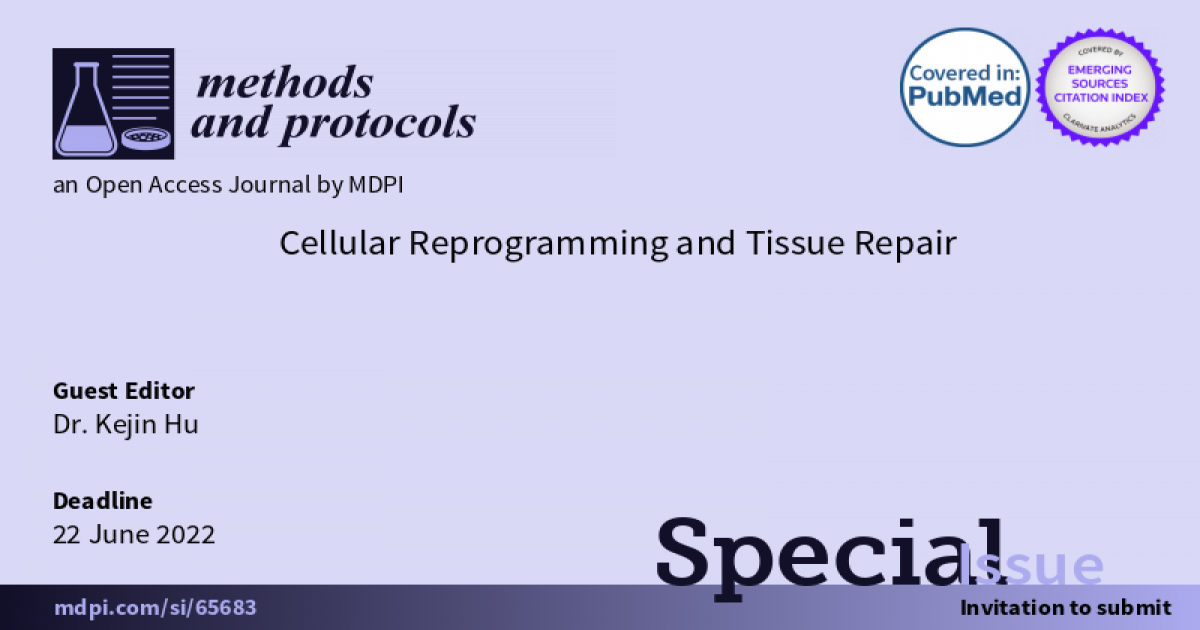Cellular Reprogramming and Tissue Repair
A special issue of Methods and Protocols (ISSN 2409-9279).
Deadline for manuscript submissions: closed (22 June 2022) | Viewed by 8215

Special Issue Editor
Interests: cellular reprogramming; pluripotent stem cells
Special Issues, Collections and Topics in MDPI journals
Special Issue Information
Dear Colleagues,
In 2006, Drs. Yamanaka and Takahashi reprogrammed mouse fibroblasts into pluripotent stem cells (PSCs) via induction by overexpression of a set of four transcription factors, Oct4, Sox2, Klf4, and c-Myc. Factor-induced PSCs (iPSCs) have since been generated from human cells of different cell types, and from many other species. Factor reprogramming has generated other functional cells as well, including induced cardiomyoctyes, induced neurons, induced beta cells, and induced blood cells, among others. This new technology opens up a new field of research—cellular reprogramming. In theory, we can now convert any cell type into another cell type of interest through epigenetic reprogramming. The means of reprogramming is no longer limited to overexpression of transcription factors. Almost all approaches have been used in reprogramming, for example, protein reprogramming, mRNA reprogramming, chemical reprogramming, microRNA reprogramming, sendai viral reprogramming, episomal reprogramming, CRISPR/activator reprogramming, reprograming with replicating viral RNA, and others. Cell fate conversion can be achieved not only in vitro, but also in living animals by delivering reprogramming factors into the target tissues. Although factor reprogramming dominates the field, the conventional technology of reprogramming by somatic cell nuclear transfer (SCNT) is still a valuable tool in both biotechnology and research. For example, SCNT is still critical in the cloning of large animals such as pigs. Cellular reprogramming is a work of art, and detailed and standardized methods and protocols are needed. This issue aims at compiling various proven bench protocols in cellular reprogramming into a single volume.
Dr. Kejin Hu
Guest Editor
Manuscript Submission Information
Manuscripts should be submitted online at www.mdpi.com by registering and logging in to this website. Once you are registered, click here to go to the submission form. Manuscripts can be submitted until the deadline. All submissions that pass pre-check are peer-reviewed. Accepted papers will be published continuously in the journal (as soon as accepted) and will be listed together on the special issue website. Research articles, review articles as well as short communications are invited. For planned papers, a title and short abstract (about 100 words) can be sent to the Editorial Office for announcement on this website.
Submitted manuscripts should not have been published previously, nor be under consideration for publication elsewhere (except conference proceedings papers). All manuscripts are thoroughly refereed through a single-blind peer-review process. A guide for authors and other relevant information for submission of manuscripts is available on the Instructions for Authors page. Methods and Protocols is an international peer-reviewed open access semimonthly journal published by MDPI.
Please visit the Instructions for Authors page before submitting a manuscript. The Article Processing Charge (APC) for publication in this open access journal is 1800 CHF (Swiss Francs). Submitted papers should be well formatted and use good English. Authors may use MDPI's English editing service prior to publication or during author revisions.
Benefits of Publishing in a Special Issue
- Ease of navigation: Grouping papers by topic helps scholars navigate broad scope journals more efficiently.
- Greater discoverability: Special Issues support the reach and impact of scientific research. Articles in Special Issues are more discoverable and cited more frequently.
- Expansion of research network: Special Issues facilitate connections among authors, fostering scientific collaborations.
- External promotion: Articles in Special Issues are often promoted through the journal's social media, increasing their visibility.
- e-Book format: Special Issues with more than 10 articles can be published as dedicated e-books, ensuring wide and rapid dissemination.
Further information on MDPI's Special Issue polices can be found here.






